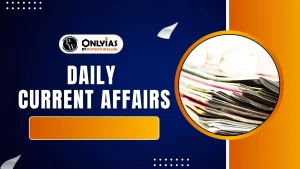Recently, the Leader of the Opposition claimed that over 1,00,000“fake votes” were created in the Mahadevapura Assembly seat under the Bangalore Central Lok Sabha constituency.
- He outlines five categories of alleged electoral malpractices:
-
- Duplicate Votes: Identical Electors Photo Identity Card (EPIC) numbers used across different states.
- Fake and Invalid Address: Voters listed with non-existent or incorrect addresses
- Bulk Voters at Single Addresses: Unusually large numbers of voters registered at a single address, often without evidence of residence.
EPIC: The EPIC (Electors Photo Identification Card) is a 10-digit alphanumeric number assigned to each registered voter by the ECI.
- It is used for identification during elections but does not grant voting rights outside the designated constituency.
Form 6: Form 6 is the application form used to register as a new voter in the electoral roll or to shift vote to a different constituency. |
-
- Invalid Photos on Voter IDs: Voter IDs with missing, incorrect, or suspicious photos, questioning their authenticity.
- Misuse of Form 6 for Registration: Fraudulent use of the voter registration application form to add invalid voters to the electoral roll.
About the Election Commission of India
- The Election Commission of India (ECI) is a permanent constitutional body responsible for conducting elections in India.
- Constitutional Basis: Part XV (Articles 324-329) of the Constitution governs elections.
- Composition: One Chief Election Commissioner (CEC) & other Election Commissioners (ECs) as determined by the President.
- Current Structure: One CEC and Two ECs.
- Powers and Functions:
- Article 324: Grants ECI the power of superintendence, direction, and control over elections to Parliament, State Legislatures, President, and Vice President.
- Appointment: Post-2023 Supreme Court ruling (Anoop Baranwal vs Union of India Case, 2023), appointments are made by a selection committee (PM, Leader of Opposition, and Union Cabinet Minister).
- Removal and Service Conditions Under Article 324(5):
- CEC Removal: Same process as that of a Supreme Court (SC) Judge.
- ECs and Regional Commissioners Removal: Only on the recommendation of the CEC.
Other Constitutional Provisions Related to Elections
- Article 325: No person can be excluded from electoral rolls based on religion, race, caste, or sex.
- Article 326: Elections to Lok Sabha & State Legislative Assemblies must be based on adult suffrage.
- Article 327: Parliament has the power to legislate on election-related matters.
- Article 328: State Legislatures can make laws on elections for their respective states.
- Article 329: Courts cannot interfere in electoral matters.
|
Supreme Court Directive in Anoop Baranwal vs Union of India Case, 2023
- Five-judge bench ruling: Directed that the CEC and ECs must be appointed by the President based on the advice of a Selection Committee.
- Composition of the Committee:
- Prime Minister.
- Leader of Opposition (LoP) in Lok Sabha.
- Chief Justice of India (CJI).
- If no LoP is available: Leader of the largest opposition party in Lok Sabha will be included.
- Parliamentary Response: Passed the CEC & Other ECs (Appointment, Conditions of Service, and Term of Office) Act, 2023 to comply with the SC directive in Anoop Baranwal v. Union of India (2023) case.
Voter Verifiable Paper Audit Trail (VVPAT)
- It is an independent system that consists of two parts, namely, a VVPAT Printer and VVPAT Status Display Unit (VSDU) attached to the Electronic Voting Machines (EVMs), that allow the voters to verify that their votes are cast as intended.
- When a vote is cast, a slip is printed containing the serial number, name, and symbol of the candidate and remains exposed through a transparent window for 7 seconds.
- It was first used in the Noksen constituency in Nagaland in 2013 and used at an all India level in the 2019 Lok Sabha Elections.
|
Challenges Related to India’s Electoral Process
- Violation of the “one person, one vote” principle: Alleged fake voter entries create unequal vote weightage.
- Campaign finance & MCC enforcement gaps: Weak implementation of spending limits and Model Code of Conduct rules.
- VVPAT Verification Limits: Only small, non-statistically significant samples are tallied.
- Technical Vulnerabilities: Inadequate safeguards for symbol loading in VVPATs; no independent expert review of Electronic Voting Machine (EVM) safeguards.
- Transparency Issues: Reluctance to retain CCTV footage from polling booths; delays in releasing final turnout data.
- Appointment Process Concerns: Government bypassing SC’s recommendation to include the CJI in the selection panel for Election Commissioners.
- Erosion of Institutional Trust: Public doubts about impartiality and transparency.
Way Forward
- Comprehensive Voter Roll Audits: Door-to-door verification and regular cleansing of rolls.
- Transparency in Data Sharing: Release voter roll data in structured, searchable formats.
- Technical Reforms: Independent audits of EVMs, full audit trails of commands, stronger protocols for symbol loading.
- Expand VVPAT Verification: Use statistically significant sampling.
- Reform Appointments: Implement SC’s recommendation for a broader, impartial selection panel for EC members.
- Engage Stakeholders: Regular consultations with political parties and civil society to strengthen trust.
Conclusion
The recent controversy underscores the pressing need for robust electoral roll reforms. By welcoming scrutiny as a means to strengthen institutions, the ECI can safeguard public trust, ensuring that democratic governance is not undermined by declining confidence in electoral processes.
![]() 11 Aug 2025
11 Aug 2025

